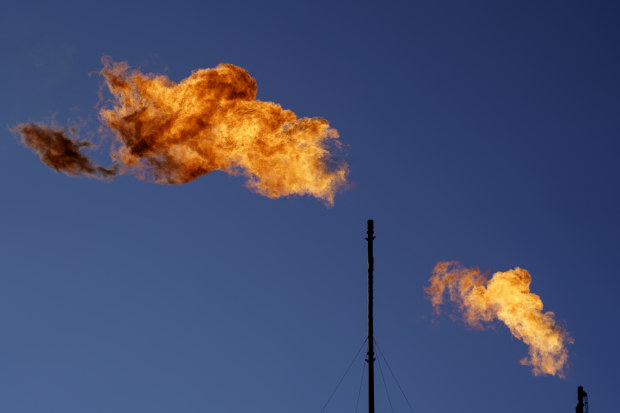Opinion

Methane is Australia’s missing COP28 opportunity
MethaneSAT, which will launch into orbit in 2024, will be a game changer for the energy sector’s abatement of a highly potent greenhouse gas.
Charlotte HansonClimate consultantCOP28 climate negotiations in Dubai have been deadlocked over the use of fossil fuels, with countries such as Australia, represented by Climate and Energy Minister Chris Bowen, pushing for an agreement to “phase out” unabated fossil fuels, while other major producers demand weaker language.
Regardless of what is decided at COP28, Australia, as one of the largest exporters of fossil fuels, and as a hopeful host of COP31, will be under increasing pressure to take decisive action on climate.

Almost two-thirds of Australia’s energy sector methane emissions can be curtailed using existing technologies at below $30/tonne CO2-equivalent. AP
What is often overlooked in discussions about the energy transition – globally, but especially in Australia – is the immediate potential for emissions reductions by addressing a highly potent greenhouse gas: methane.
Per unit released, methane causes more than 80 times the climate damage of carbon dioxide over a 20-year period. Emissions primarily come from agriculture, the energy sector and waste.
One of the fastest and cheapest ways to curb global warming is to stop methane pollution from the energy sector – particularly from coal and gas facilities. Methane escapes continuously from these facilities through unintended leaks as well as deliberate venting and flaring.
Australia, as a major exporter of LNG and coal, is failing to take serious action on methane. Meanwhile, our strategic partners are getting on with it.
At COP28, more than 50 companies signed onto the new Oil and Gas Decarbonisation Charter, under which operators agree to limit methane emissions to just 0.2 per cent of total production, and stop their wasteful routine flaring of methane, by 2030. Signatories also agree to submit their emissions data for independent verification.
Australia could rapidly decrease its emissions and respond to growing trade and geopolitical pressure.
In the lead-up to COP28, the European Union finalised strong new rules to limit methane emissions from the energy sector, and China committed to reining in methane emissions under a new national plan in collaboration with the US.
Separately, the US recently unveiled sweeping new rules targeting methane from its oil and gas sector. These build on reforms under the Inflation Reduction Act legislation last year that introduced a penalty for oil and gas companies that exceed 0.2 per cent methane emitted from production.
And in July, Japan’s JERA and South Korea’s Kogas initiated a program to reduce methane pollution in the LNG value chain, including asking gas suppliers to start providing data on their emissions.
Currently, Australia’s coal and gas methane reporting is based on desktop estimates, which are routinely shown to undercount emissions when compared with empirical measurements. Australian regulators have also failed to implement the globally accepted best practice of limiting methane emissions to a maximum of 0.2 per cent of production.
In the absence of regulatory requirements, companies tend not to prioritise their methane problem, partly due to lack of awareness of how significant their emissions actually are.
Unlike some speculative carbon abatement techniques, technologies for both measuring and abating methane are readily available and cost-effective. About 30 firms in Australia are already offering ground-based monitoring technologies such as handheld gas imaging cameras to assist in leak detection, while more than 10 provide drone and aerial sensing solutions.
Existing technologies
In addition to monitoring, many firms in Australia also offer abatement technologies that can make a material difference to emissions. For the gas sector, operators can install devices to capture gas that would otherwise be vented for operational reasons. There are also services to replace existing devices that are leaking such as pumps and compressor seals.
For coal, available technologies include drainage gas utilisation for open-cut and underground mines, and sealing and rerouting. Energy consultancy Rystad estimates 65 per cent of Australia’s energy sector methane emissions can be curtailed using existing technologies at below $30/tonne CO2-equivalent.
In contrast to carbon, for a gas company, lost methane is a wasted product, so capturing it makes good economic sense. Rystad found up to 50 per cent of the Australian industry’s emissions can be captured at a profit to companies. Even for coal production – a far greater source of methane pollution in Australia – 20 per cent of methane emissions could be cut profitably.
Not only are established tracking and abating technologies becoming more widely available, but so too are open-source technologies. For those looking to solve methane problems, these technologies are a godsend. For those wanting to continue “business as usual”, they present an important challenge.
One such technology in this realm is MethaneSAT, which will launch into orbit in 2024. MethaneSAT is a satellite mission and wholly owned subsidiary of global NGO Environmental Defence Fund. It will measure methane pollution from fossil fuel facilities across the world, and make that information freely accessible for public scrutiny.
This kind of transparency and accountability will be a game changer in the fight to tackle methane. The sophistication of MethaneSAT and the public’s ability to see the satellite’s data in near real time will make it very difficult for companies and governments to deny there is a big methane problem, including in Australia.
By developing policies and harnessing technologies to accurately measure and abate energy sector methane, Australia could rapidly decrease its emissions and respond to growing trade and geopolitical pressure – the kind of substantial initiative that would show tangible results ahead of the next election and assist in our bid to co-host the climate COP in 2026.
Introducing your Newsfeed
Follow the topics, people and companies that matter to you.
Find out moreRead More
Latest In Energy & climate
Fetching latest articles